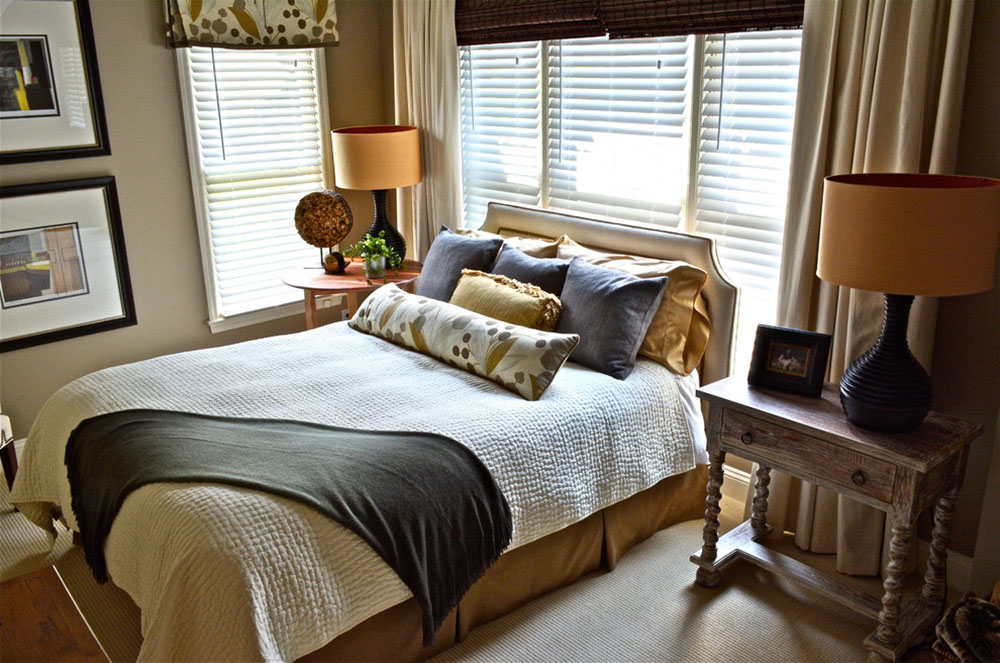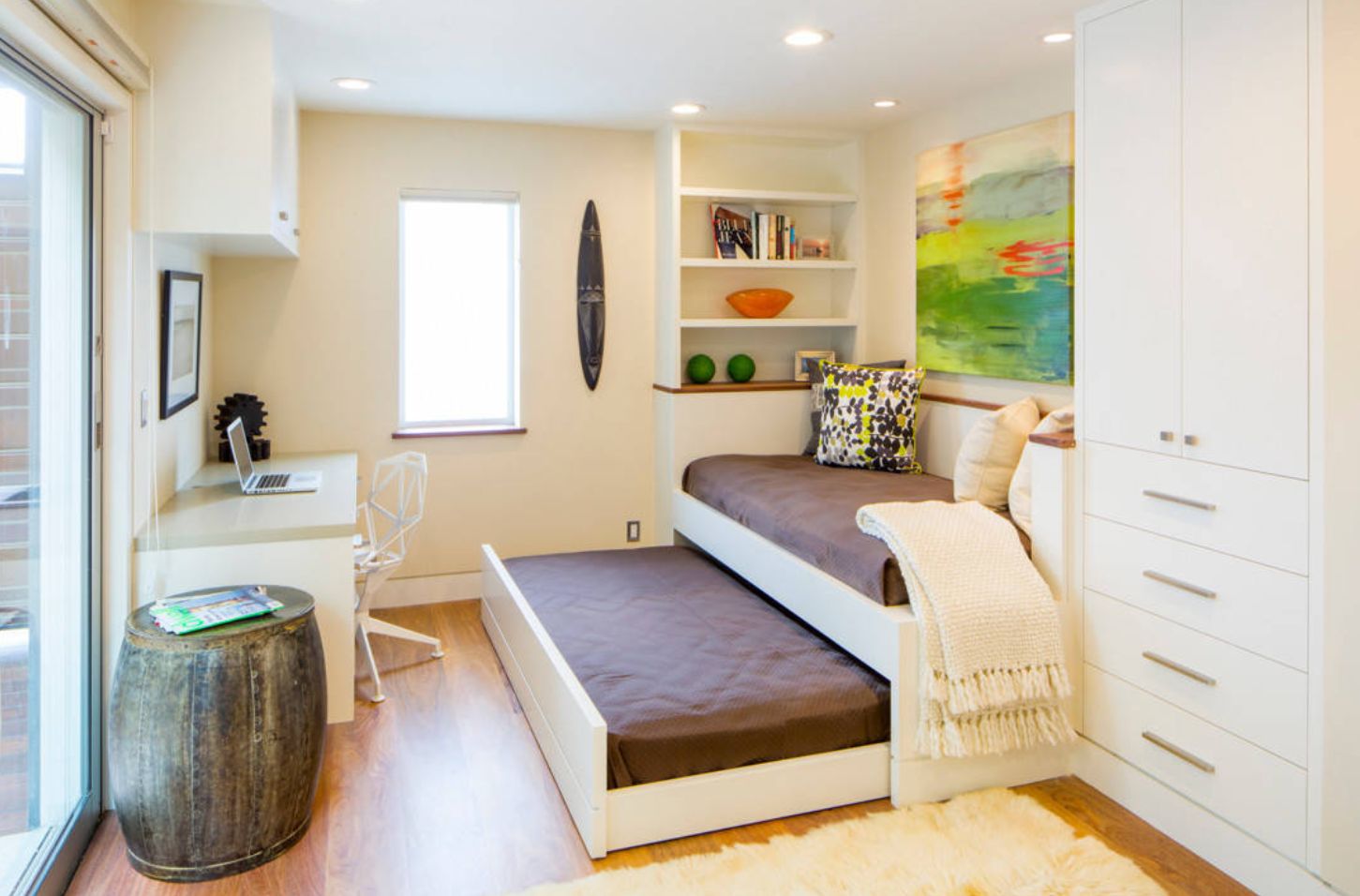Space Optimization Strategies

A small bedroom with a full-size bed presents a unique challenge, but with clever planning and creative solutions, you can maximize space utilization and create a functional and inviting haven. This section delves into various space optimization strategies that will help you transform your small bedroom into a comfortable and efficient living space.
Furniture Arrangement for Spaciousness
Strategic furniture placement plays a crucial role in creating a sense of spaciousness. Here are some arrangements that maximize space and create a visually appealing flow:
- Floating Bed: A floating bed, which appears to be suspended in the air, is an excellent choice for small bedrooms. It creates an illusion of more floor space and allows for easier cleaning underneath. This is achieved by mounting the bed frame to the wall, eliminating the need for bulky bed legs.
- Multi-functional Furniture: Consider furniture that serves multiple purposes. For example, a storage bed with built-in drawers or a convertible sofa that transforms into a bed can save valuable floor space. This strategy allows you to consolidate your furniture needs and maximize the available area.
- Strategic Placement: Avoid placing furniture directly against the walls. Instead, use the walls for storage solutions, such as shelves or cabinets, and place furniture slightly away from the walls to create a sense of spaciousness.
Selecting Multi-functional Furniture
Multi-functional furniture pieces are essential for small bedrooms, as they maximize space utilization and offer versatility. Here are some examples:
- Ottoman with Storage: An ottoman with built-in storage can serve as a footrest, extra seating, and a convenient place to store blankets, pillows, or other items.
- Mirror with Shelf: A mirror with a built-in shelf can reflect light, creating an illusion of more space. The shelf can be used to store books, small accessories, or decorative items.
- Fold-down Desk: A fold-down desk attached to the wall can provide a workspace when needed and fold away neatly when not in use. This eliminates the need for a dedicated desk and frees up valuable floor space.
Layout for a Small Bedroom, Full size bed in small bedroom
Here is a sample layout for a small bedroom with a full-size bed, incorporating storage solutions and maximizing floor space:
- Bed Placement: Position the bed against the longest wall, leaving enough space for walking around it. If the room is narrow, consider placing the bed lengthwise to maximize space.
- Storage Solutions: Incorporate storage solutions around the bed, such as built-in drawers or shelves, to maximize storage capacity without cluttering the floor space.
- Nightstands: Opt for small nightstands or floating shelves instead of bulky nightstands to create a sense of spaciousness.
- Dresser Placement: Place the dresser against a wall that is not directly opposite the bed, leaving space for a walkway and a mirror. Alternatively, consider using a slim dresser or a chest of drawers instead of a traditional dresser.
Using Mirrors to Create the Illusion of Larger Space
Mirrors play a crucial role in creating an illusion of larger space. Here are some tips for using mirrors effectively:
- Placement: Place a large mirror opposite a window or a light source to reflect light and create a brighter, more spacious feel. Avoid placing mirrors directly across from the bed, as it can be distracting or unsettling.
- Size: Use large mirrors to create the most dramatic effect. Smaller mirrors can be used strategically to highlight specific areas of the room.
- Framing: Consider using mirrors with simple frames or no frames at all to avoid creating visual clutter.
Furniture Selection and Placement

In a small bedroom with a full-size bed, every piece of furniture counts. Careful selection and strategic placement are crucial to creating a space that feels both comfortable and functional. This section explores furniture choices, placement tips, and items to avoid in a small bedroom with a full-size bed.
Choosing Essential Furniture
The key to furnishing a small bedroom with a full-size bed is to prioritize essential pieces that serve multiple purposes. The following furniture items are generally considered essential:
- Full-Size Bed: This is the focal point of the room and should be selected based on comfort, style, and space considerations.
- Nightstands: Nightstands provide a convenient surface for essentials like books, lamps, and alarm clocks. They should be scaled appropriately to the size of the bed and the room.
- Storage Solutions: Small bedrooms require creative storage solutions. This could include a dresser, chest of drawers, under-bed storage, or a combination of these options.
- Seating: A small chair or ottoman can provide a comfortable spot to sit and put on shoes or read a book.
- Lighting: Adequate lighting is crucial for a welcoming bedroom. Consider a combination of overhead lighting, lamps, and possibly a bedside reading lamp.
Comparing Bed Types
The choice of bed can significantly impact the feel of a small bedroom. Here’s a comparison of common bed types suitable for small spaces:
| Bed Type | Advantages | Disadvantages |
|---|---|---|
| Full-Size Platform Bed | Low profile, often with built-in storage, visually expands the room | May not be suitable for all mattress types |
| Full-Size Canopy Bed | Adds a touch of elegance, can create a cozy feel | Can be bulky and visually overwhelming in a small room |
| Full-Size Storage Bed | Maximizes storage space, ideal for hiding clutter | May be more expensive than traditional beds |
Selecting Headboards
Headboards can enhance the style and functionality of a bed. Consider these factors when choosing a headboard for a small bedroom:
- Size: Choose a headboard that is proportional to the bed and the room. Oversized headboards can make a small room feel cramped.
- Style: Headboards come in a variety of styles, from minimalist to ornate. Choose a style that complements the overall design of the room.
- Functionality: Some headboards have built-in shelves or storage compartments, which can be helpful in a small bedroom.
Choosing Nightstands
Nightstands are essential for convenience and storage. Here are some tips for selecting nightstands for a small bedroom:
- Size: Nightstands should be scaled to the size of the bed and the room. Avoid overly large or bulky nightstands.
- Storage: Look for nightstands with drawers, shelves, or other storage features to maximize functionality.
- Style: Choose nightstands that complement the style of the bed and the room.
Furniture Placement Tips
Strategic furniture placement is key to maximizing space and creating a balanced atmosphere:
- Center the Bed: Place the bed in the center of the wall, leaving enough space to move around it comfortably.
- Use Corners Wisely: Utilize corners for small furniture pieces, such as a chair or an ottoman.
- Create a Focal Point: Use furniture placement to draw attention to a specific area of the room, such as the bed or a window.
- Maintain Traffic Flow: Ensure that there is enough space to move around freely within the room.
Furniture to Avoid
In a small bedroom with a full-size bed, it’s important to avoid furniture that can contribute to clutter and cramped feeling:
- Large Armoires: Armoires can be bulky and take up valuable floor space.
- Oversized Dressers: Choose dressers that are scaled to the size of the room.
- Unnecessary Furniture: Avoid purchasing furniture that serves no practical purpose.
Decorating Tips and Techniques: Full Size Bed In Small Bedroom

Decorating a small bedroom with a full-size bed requires careful consideration of color palettes, patterns, and design elements to create a visually appealing and spacious environment. By employing smart decorating techniques, you can maximize the room’s potential and transform it into a comfortable and inviting sanctuary.
Color Palettes and Patterns
Choosing the right color palette and patterns is crucial for visually expanding a small bedroom. Light and airy colors, such as white, cream, pale blues, and soft grays, can create a sense of spaciousness. Using a single dominant color and introducing accent colors through textiles, artwork, or accessories can add visual interest without overwhelming the space.
- Light and Airy Colors: Opt for light colors like white, cream, pale blues, and soft grays to make the room appear larger and brighter. These colors reflect light, creating a sense of openness and spaciousness.
- Monochromatic Color Scheme: Employ a monochromatic color scheme, using different shades of the same color to create visual interest and depth. For example, using various shades of blue can create a calming and cohesive atmosphere.
- Accent Colors: Introduce pops of color with accent colors through textiles, artwork, or accessories. This can add visual interest and personality to the room without overwhelming the space.
- Patterns: Choose small-scale patterns like stripes, polka dots, or floral prints in light colors. Avoid large-scale patterns that can make the room feel smaller.
Wall Decor and Lighting
Wall decor and lighting play a significant role in enhancing the aesthetic appeal of a small bedroom.
- Mirrors: Mirrors strategically placed on walls can reflect light and create the illusion of more space. Consider a large mirror above the dresser or a smaller one on a side wall.
- Wall Art: Opt for artwork with light and airy themes or abstract designs that create a sense of movement. Avoid overly busy or dark artwork that can make the room feel cramped.
- Lighting: Adequate lighting is essential for creating a welcoming and functional space. Consider a combination of ambient lighting, such as a ceiling fixture, and task lighting, such as bedside lamps or sconces.
- Layered Lighting: Use a combination of different light sources to create a warm and inviting atmosphere. This can include overhead lighting, bedside lamps, and accent lighting.
Textiles and Accessories
Textiles and accessories are powerful tools for creating a cohesive and inviting atmosphere in a small bedroom.
- Bed Linens: Choose bed linens in light colors and patterns to enhance the sense of spaciousness. Consider using a duvet cover with a simple design or a textured throw blanket for added comfort.
- Curtains: Opt for sheer or lightweight curtains that allow natural light to filter into the room. Avoid heavy curtains that can make the space feel smaller.
- Rugs: A rug can define the space and add a touch of personality. Choose a rug in a light color and a simple design that complements the overall color scheme.
- Throws and Pillows: Add texture and color with throws and pillows. Choose items in complementary colors and patterns that create visual interest.
Personal Touches and Accents
Incorporating personal touches and accents is essential for creating a personalized and inviting space.
- Family Photos: Display family photos in a gallery wall or on a bedside table. This adds a personal touch and creates a sense of warmth and belonging.
- Travel Souvenirs: Incorporate travel souvenirs as decorative accents. This can be anything from a small sculpture to a framed postcard.
- Plants: Add a touch of nature with plants. Choose low-maintenance plants that thrive in indoor environments.
Full size bed in small bedroom – Fitting a full-size bed into a small bedroom can be a challenge, but maximizing space is key. A small storage bench for bedroom can be a practical solution. Not only does it provide a comfortable seating option, but it also offers hidden storage for blankets, pillows, or even off-season clothing, freeing up valuable floor space and creating a more organized, spacious feel around your full-size bed.
Fitting a full-size bed into a small bedroom can be a challenge, but it’s achievable with smart design choices. A calming color palette can help to create a sense of spaciousness, and a lilac and blue bedroom offers a tranquil backdrop.
The light and airy hues create a sense of calm, while the strategic use of mirrors and strategically placed furniture can further enhance the illusion of space.
